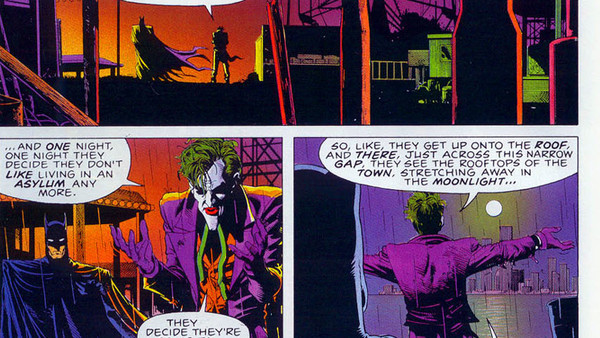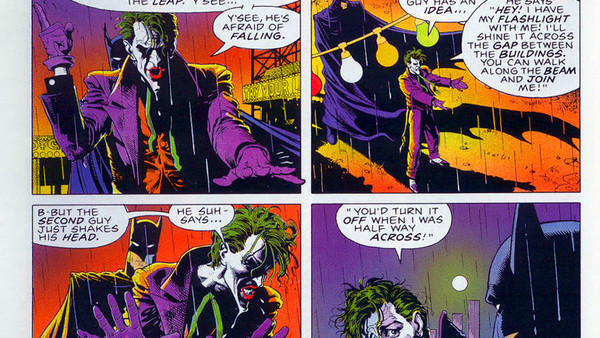What Does The Final Image Of The Killing Joke REALLY Mean?
2. There Were These Two Guys In A Lunatic Asylum...

So, does Joker actually die in The Killing Joke? There's no definitive answer, and examples from the text could be considered circumstantial at best, but the crux of the argument lies in the joke the Clown Prince tells in the book's final few panels.
After sincerely informing Batman that he can't, in fact, be saved, Joker does what he does best and begins to tell a joke. This one revolves around 'two guys in a lunatic asylum', and how, one night, they decide to make a last ditch attempt at escaping. The two actors in this anecdote are clearly meant to be Batman and Joker, with the Dark Knight being the one who promises to shine the flashlight across the buildings so they can escape, and the Joker being the one too afraid to make that leap.
Here, Joker acknowledges that he, like Batman, wants to escape this cycle - he's just too afraid to do so. The importance of the anecdote is hammered home further through Bolland's use of light; Joker, right as he approaches the concept of freedom in his joke, looks to the moon. As he continues, the lights of some nearby police cars cast a thin light on the deepening puddle beneath the two characters. It's the same light from Joker's story, promising both he and Batman a life free from their twisted fellowship. Like the actors in his joke however, neither he or the Caped Crusader are able to mount the escape they want to, with the light closing just as Joker's laughter - and the police sirens close by - come to a sudden end.
Is this closing of the gap - as Morrison claims - confirmation that Batman kills Joker? It makes sense, especially since - in Joker's story - Batman represents the one character who's already made that leap to freedom. Joker not joining him then could have - as Morrison's theory goes - forced Batman's hand; their one last chance to escape was over.

Batman killing Joker also ties into Batman's earlier interrogation with the fake Clown Prince, where he proclaims that the pair will kill each other eventually. "Perhaps you'll kill me. Perhaps I'll kill you. Perhaps sooner. Perhaps later." In The Killing Joke, Batman's worst adversary commits his most heinous crimes, and in attacking those closest to the Dark Knight, it would make sense that the ending he prophesied at the beginning of the novel would come to fruition - perhaps sooner.
Add to that the sudden end of Joker's laughter, and there's a solid case to be made that Joker's last laugh was had in Moore's comic.
There is another interpretation however, and one that, in many respects, is even more tragic than Morrison's own. In this case, the anecdote's importance remains the same, but the closing of the light doesn't (immediately) bear the lethal consequences of that other one. Rather, it consigns both actors to their relationship ad infintium. Joker and Batman are doomed to repeat this cycle forever, with no logical end in sight. It isn't triumphant, but it denies Joker his victory, with Jim and Barbara Gordon both rubbishing the notion that all it takes is 'one bad day' to experience the reality the former Red Hood does day in, day out.
There's also the simple fact that, after The Killing Joke, the character has made plenty of appearances. Were we to take Moore's comic as Morrison does however, as the 'last' Batman story, it would still leave the Clown Prince's fate in the balance, irrespective of Bats' own no killing rule.